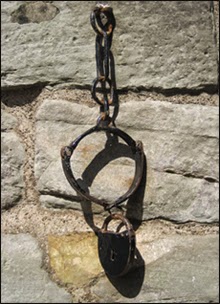While I’m sure almost all of us will be celebrating Halloween today (hooray!), very few of you will still be honoring the Pagan holiday of Samhain (sah-win), which begins tonight at sundown. Celebrated in Celtic countries, Samhain marked the beginning of winter and many rituals and festivities took place over the night.
 Although Samhain was a
time to prepare for winter, it was also very much a festival of the
dead, as the Irish believed that on this night the doorways to the
Otherworld opened and spirits were allowed access into our realm.
Although Samhain was a
time to prepare for winter, it was also very much a festival of the
dead, as the Irish believed that on this night the doorways to the
Otherworld opened and spirits were allowed access into our realm.It was believed that dead family members would return to their homes to warm themselves by their fireside so a fire was, of course, kept roaring, and a place at the table was sat for the ghost. The sídhe were also free to walk the Earth on Samhain; the sídhe are a race of supernatural beings that come in many forms, but are all essentially nature spirits, or, in other words, faeries, elves, goblins and that sort of thing.
 The
Irish have utmost fear and respect for the sídhe and would take great
care to make sure they were comfortable on Samhain. They would place
offerings of their doorsteps in the form of food and drink in hopes that
the sídhe would help their crops to prosper next harvest. Trick ‘r’
treating comes directly from a symbolic ritual that the Celts would
perform on Samhain.
The
Irish have utmost fear and respect for the sídhe and would take great
care to make sure they were comfortable on Samhain. They would place
offerings of their doorsteps in the form of food and drink in hopes that
the sídhe would help their crops to prosper next harvest. Trick ‘r’
treating comes directly from a symbolic ritual that the Celts would
perform on Samhain.People would dress up in costumes—that were, rather, disguises to hide their human selves from the sídhe—and go house to house singing Pagan songs or reciting poetry. The owner of the house was then expected to reward them with food (which was gathered for a enormous feast), and if they did not, bad luck was sure to come upon them.
The sídhe love to play tricks and fool people, so, naturally, if one is dressed up as one of the sídhe they may as well act like one, and because of all the prank playing Samhain eventually gained the nickname “Mischief Night”. In modern times Mischief Night is commonly celebrated the night before Halloween and teenagers are encouraged to go out and perform pranks such as TP'ing houses. In Canada it is called Devil’s Night.
 While some spirits were welcomed to
return, there were also many precautions taken to keep dark forces at
bay; the most famous one now being jack-o-lanterns (also made out of
turnips), which were hollowed out and lit to intimidate evil spirits and
frighten them away. Huge bonfires were lit on the night of Samhain to
keep spirits away, and smoke was thought to cleansing and protecting.
While some spirits were welcomed to
return, there were also many precautions taken to keep dark forces at
bay; the most famous one now being jack-o-lanterns (also made out of
turnips), which were hollowed out and lit to intimidate evil spirits and
frighten them away. Huge bonfires were lit on the night of Samhain to
keep spirits away, and smoke was thought to cleansing and protecting.If one is walking down the road on Halloween night and hears someone walking up behind them, they must not turn around, for if they do they could look Death in the face, therefore quickening their own timeline to the grave.
Those born on Halloween are given the gift of second-sight, the ability to see ghosts and faeries. They are also granted protection from them.
On Samhain and Halloween there were many ways to tell the future, and many strange ways to go about doing it. Some of the more easy ways are going to a crossroads, and in the voice of the whispering wind you will hear tell of events in the upcoming year. If you visit a churchyard when the clock strikes midnight, you will hear a voice list out the name of locals who will die within twelve months.
The divination rituals dealt almost exclusively with death and marriage. In aspect to the latter, a girl who looks in the mirror while combing her hair and eating an apple may catch a glimpse of her future husband’s image in the mirror. There are a handful of traditions that involve apples, including the tradition that has now become bobbing for apples. A long time ago the children used to take the apple they plucked out of the bucket home with them to put under their pillow, in the hopes that in their sleep they would be visited by their future spouse.
While many of the core themes and traditions of Samhain still exist today, few may know the origins behind them. For me, knowing the roots of the legends makes them even more magical and makes me enjoy my favorite day of the year even more.
Happy Halloween everyone, and thank you for joining us in another year's festival of fear!


























































